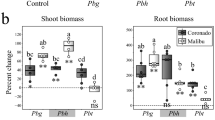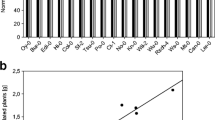Abstract
Plant secondary metabolites, particularly flavonoids, are key components in the early stages of nitrogen-fixing symbiosis. Despite their importance, the endogenous secondary metabolites involved in symbiosis have not yet been identified in the model legume Lotus japonicus. We therefore determined changes in the secondary metabolic profile of Lotus japonicus roots in response to its symbiont. Analysis of the root secondary metabolite profiles 1 week after inoculation with Mesorhizobium loti revealed quantitative changes in the level of 14 phenolic peaks when compared with non-inoculated control plants. These changes affected compounds from most phenolic classes, possibly resulting from interconversion between classes since the total phenolic level remained constant. In addition, the use of 2 M. loti strains differing only in their capacity to synthesise Nod factor revealed that, although Nod factor signalling induced accumulation of a specific subset of 4 phenolic peaks, most changes were induced in response to both rhizobial strains.



Similar content being viewed by others
References
Colebatch G, Desbrosses G, Ott T, Krusell L, Montanari O, Kloska S, Kopka J, Udvardi MK (2004) Global changes in transcription orchestrate metabolic differentiation during symbiotic nitrogen fixation in Lotus japonicus. Plant J 39:487–512
Cooper JE (2007) Early interactions between legumes and rhizobia: disclosing complexity in a molecular dialogue. J Appl Microbiol 103:1355–1365
Cooper JE, Rao JR (1992) Localised changes in flavonoid biosynthesis in roots of Lotus pedunculatus after infection by Rhizobium loti. Plant Physiol 100:444–450
Desbrosses G, Kopka J, Udvardi MK (2005) Lotus japonicus metabolic profiling. Development of gas chromatography-mass spectrometry resources for the study of plant-microbe interactions. Plant Physiol 137:1302–1318
Djordjevic MA, Mathesius U, Arioli T, Weinman JJ, Gartner E (1997) Chalcone synthase gene expression in transgenic subterranean clover correlates with localised accumulation of flavonoids. Aust J Plant Physiol 24:119–132
Edwards R, Tiller SA, Parry AD (1997) The effect of plant age and nodulation on the isoflavonoid content of red clover (Trifolium pratense). J Plant Physiol 150:603–610
Estabrook EM, Senguptagopalan C (1991) Differential expression of phenylalanine ammonia-lyase and chalcone synthase during soybean nodule development. Plant Cell 3:299–308
Gagnon H, Ibrahim RK (1998) Aldonic acids: a novel family of nod gene inducers of Mesorhizobium loti, Rhizobium lupini and Sinorhizobium meliloti. Mol Plant Microbe Interact 11:988–998
Geurts R, Fedorova E, Bisseling T (2005) Nod factor signaling genes and their function in the early stages of Rhizobium infection. Curr Opin Plant Biol 8:346–352
Grandmaison J, Ibrahim R (1995) Ultrastructural-localization of a diprenylated isoflavone in Rhizobium lupini-Lupinus albus symbiotic association. J Exp Bot 46:231–237
Handberg K, Stougaard J (1992) Lotus japonicus, an autogamous, diploid legume species for classical and molecular-genetics. Plant J 2:487–496
Hotter GS, Scott DB (1991) Exopolysaccharide mutants of Rhizobium loti are fully effective on determinate nodulating host but ineffective on an indeterminate nodulating host. J Bacteriol 173:851–859
Jacobs M, Rubery PH (1988) Naturally-occurring auxin transport regulators. Science 241:346–349
Jones KM, Kobayashi H, Davies BW, Taga ME, Walker GC (2007) How rhizobial symbionts invade plants: the Sinorhizobium-Medicago model. Nat Rev Microbiol 5:619–633
Jones KM, Sharopova N, Lohar DP, Zhang JQ, VandenBosch KA, Walker GC (2008) Differential response of the plant Medicago truncatula to its symbiont Sinorhizobium meliloti or an exopolysaccharide-deficient mutant. Proc Natl Acad Sci USA 105:704–709
Kape R, Parniske M, Brandt S, Werner D (1992) Isoliquiritigenin, a strong nod gene-inducing and glyceollin resistance-inducing flavonoid from soybean root exudate. Appl Environ Microbiol 58:1705–1710
Lawson CGR, Rolfe BG, Djordjevic MA (1996) Rhizobium inoculation induces condition-dependent changes in the flavonoid composition of root exudates from Trifolium subterraneum. Aust J Plant Physiol 23:93–101
Lepek VC, D’Antuono AL, Tomatis PE, Ugalde JE, Giambiagi S, Ugalde RA (2002) Analysis of Mesorhizobium loti glycogen operon: effect of phosphoglucomutase (pgm) and glycogen synthase (glgA) null mutants on nodulation of Lotus tenuis. Mol Plant Microbe Interact 15:368–375
Lohar DP, Sharopova N, Endre G, Peñuela S, Samac D, Town C, Silverstein KAT, VandenBosch KA (2006) Transcript analysis of early nodulation events in Medicago truncatula. Plant Physiol 140:221–234
López-Lara IM, Vandenberg JDJ, Thomasoates JE, Glushka J, Lugtenberg BJJ, Spaink HP (1995) Structural identification of the lipo-chitin oligosaccharide nodulation signals of Rhizobium loti. Mol Microbiol 15:627–638
Mahmoud ZF, Amer ME, Abdel-Kader MA, Abdel-Salam NA (1990) A coumestan from Lotus creticus. Phytochemistry 29:355–356
Mathesius U (2001) Flavonoids induced in cells undergoing nodule organogenesis in white clover are regulators of auxin breakdown by peroxidase. J Exp Bot 52:419–426
Mathesius U, Bayliss C, Weinman JJ, Schlaman HRM, Spaink HP, Rolfe BG, McCully ME, Djordjevic MA (1998a) Flavonoids synthesized in cortical cells during nodule initiation are early developmental markers in white clover. Mol Plant Microbe Interact 11:1223–1232
Mathesius U, Schlaman HRM, Spaink HP, Sautter C, Rolfe BG, Djordjevic MA (1998b) Auxin transport inhibition precedes root nodule formation in white clover roots and is regulated by flavonoids and derivatives of chitin oligosaccharides. Plant J 14:23–34
Maxwell CA, Hartwig UA, Joseph CM, Phillips DA (1989) A chalcone and 2 related flavonoids released from alfalfa roots induce nod genes of Rhizobium meliloti. Plant Physiol 91:842–847
McKhann HI, Paiva NL, Dixon RA, Hirsch AM (1997) Chalcone synthase transcripts are detected in alfalfa root hair following inoculation with wild-type Rhizobium meliloti. Mol Plant Microbe Interact 10:50–58
Oldroyd GE, Downie JA (2008) Coordinating nodule morphogenesis with rhizobial infection in legumes. Annu Rev Plant Biol 59:519–546
Pankhurst CE, Jones WT (1979) Effectiveness of Lotus root nodules. III. Effect of combined nitrogen on nodule effectiveness and flavolan synthesis in plant roots. J Exp Bot 30:1109–1118
Recourt K, Schripsema J, Kijne JW, Vanbrussel AAN, Lugtenberg BJJ (1991) Inoculation of Vicia sativa subsp nigra roots with Rhizobium leguminosarum biovar viciae results in release of nod gene activating flavanones and chalcones. Plant Mol Biol 16:841–852
Riely BK, Ané JM, Penmetsa RV, Cook DR (2004) Genetic and genomic analysis in model legumes bring Nod-factor signaling to center stage. Curr Opin Plant Biol 7:408–413
Rispail N, Morris PM, Webb KJ (2005a) Phenolic compounds: extraction and analysis. In: Márquez AJ, Stougaard J, Udvardi MK, Parniske M, Spaink HP, Saalbach G, Webb KJ, Chiurazzi M, Márquez AJ (eds) Lotus japonicus handbook. Springer, Dordrecht, pp 349–354
Rispail N, Nash RJ, Webb KJ (2005b) Secondary metabolite profiling. In: Márquez AJ, Stougaard J, Udvardi MK, Parniske M, Spaink HP, Saalbach G, Webb KJ, Chiurazzi M, Márquez AJ (eds) Lotus japonicus handbook. Springer, Dordrecht, pp 341–348
Robbins MP, Thomas B, Morris PM (1995) Phenylpropanoid defence responses in transgenic Lotus corniculatus II. Modelling plant defence responses in transgenic root cultures using thiol and carbohydrate elicitors. J Exp Bot 46:513–524
Robbins MP, Bavage AD, Strudwicke C, Morris PM (1998) Genetic manipulation of condensed tannins in higher plants II. Analysis of birdsfoot trefoil plants harboring antisense dihydroflavonol reductase constructs. Plant Physiol 116:1133–1144
Ryle GJA, Powell CE, Gordon AJ (1978) Effect of source of nitrogen on growth of fiskeby soya bean—carbon economy of whole plants. Ann Bot 42:637–648
Shaw SL, Long SR (2003) Nod factor inhibition of reactive oxygen efflux in a host legume. Plant Physiol 132:2196–2204
Scott DB, Young CA, Collins-Emerson JM, Terzaghi EA, Rockman ES, Lewis PE, Pankhurst CE (1996) Novel and complex chromosomal arrangement of Rhizobium loti nodulation genes. Mol Plant Microbe Interact 9:187–197
Stafford HA (1997) Roles of flavonoids in symbiotic and defense functions in legume roots. Bot Rev 63:27–39
Steele HL, Werner D, Cooper JE (1999) Flavonoids in seed and root exudates of Lotus pedunculatus and their biotransformation by Mesorhizobium loti. Physiol Plant 107:251–258
Subramanian S, Stacey G, Yu O (2007) Distinct, crucial roles of flavonoids during legume nodulation. Trends Plant Sci 12:282–285
Tellström V, Usadel B, Thimm O, Stitt M, Küster H, Niehaus K (2007) The lipopolysaccharide of Sinorhizobium meliloti suppresses defence-associated gene expression in cell cultures of the host plant Medicago truncatula. Plant Physiol 143:825–837
Tiller SA, Parry AD, Edwards R (1994) Changes in the accumulation of flavonoid and isoflavonoid conjugates associated with plant-age and nodulation in alfalfa (Medicago sativa). Physiol Plant 91:27–36
Turska-Szewczuk A, Łotocka B, Kutkowska J, Król J, Urbanik-Sypniewska T, Russa R (2009) The incomplete substitution of lipopolysaccharide with O-chain prevents the establishment of effective symbiosis between Mesorhizobium loti NZP2213.1 and Lotus corniculatus. Microbiol Res 164:163–173
Wasson AP, Pellerone FI, Mathesius U (2006) Silencing the flavonoid pathway in Medicago truncatula inhibits root nodule formation and prevents auxin transport regulation by rhizobia. Plant Cell 18:1617–1629
Wienkoop S, Saalbach G (2003) Proteome analysis. Novel proteins identified at the peribacteroid membrane from Lotus japonicus root nodules. Plant Physiol 131:1080–1090
Yang SS, Gao F, Mabry TJ, Amer ME, Abdel-Kader MA, Mahmoud ZF, Abdel-Salam NA (1989) Flavonoids from Lotus creticus. Phytochemistry 28:1749–1750
Zaat SAJ, Schripsema J, Wijffelman CA, Vanbrussel AAN, Lugtenberg BJJ (1989) Analysis of the major inducers of the Rhizobium NodA promoter from Vicia sativa root exudate and their activity with different NodD genes. Plant Mol Biol 13:175–188
PATENTS
Process for extracting polar phytochemicals (2002) EP 03706756.8
Method for monitoring the quality of a herbal medicine (2002) EP03706757.6
Acknowledgements
Authors thank Ruth Sanderson for her invaluable help on statistical analysis of the data and Jo Spikes for careful reading of the manuscript. NR was supported by a Training Network funded by the European Training Network EU-RTN-LOTUS-HPRN-CT-2000-00086. KJW was supported by core funding from the Biotechnology and Biological Science Research Council (BBSRC), UK.
Author information
Authors and Affiliations
Corresponding author
Rights and permissions
About this article
Cite this article
Rispail, N., Hauck, B., Bartholomew, B. et al. Secondary metabolite profiling of the model legume Lotus japonicus during its symbiotic interaction with Mesorhizobium loti . Symbiosis 50, 119–128 (2010). https://doi.org/10.1007/s13199-010-0053-7
Received:
Accepted:
Published:
Issue Date:
DOI: https://doi.org/10.1007/s13199-010-0053-7




